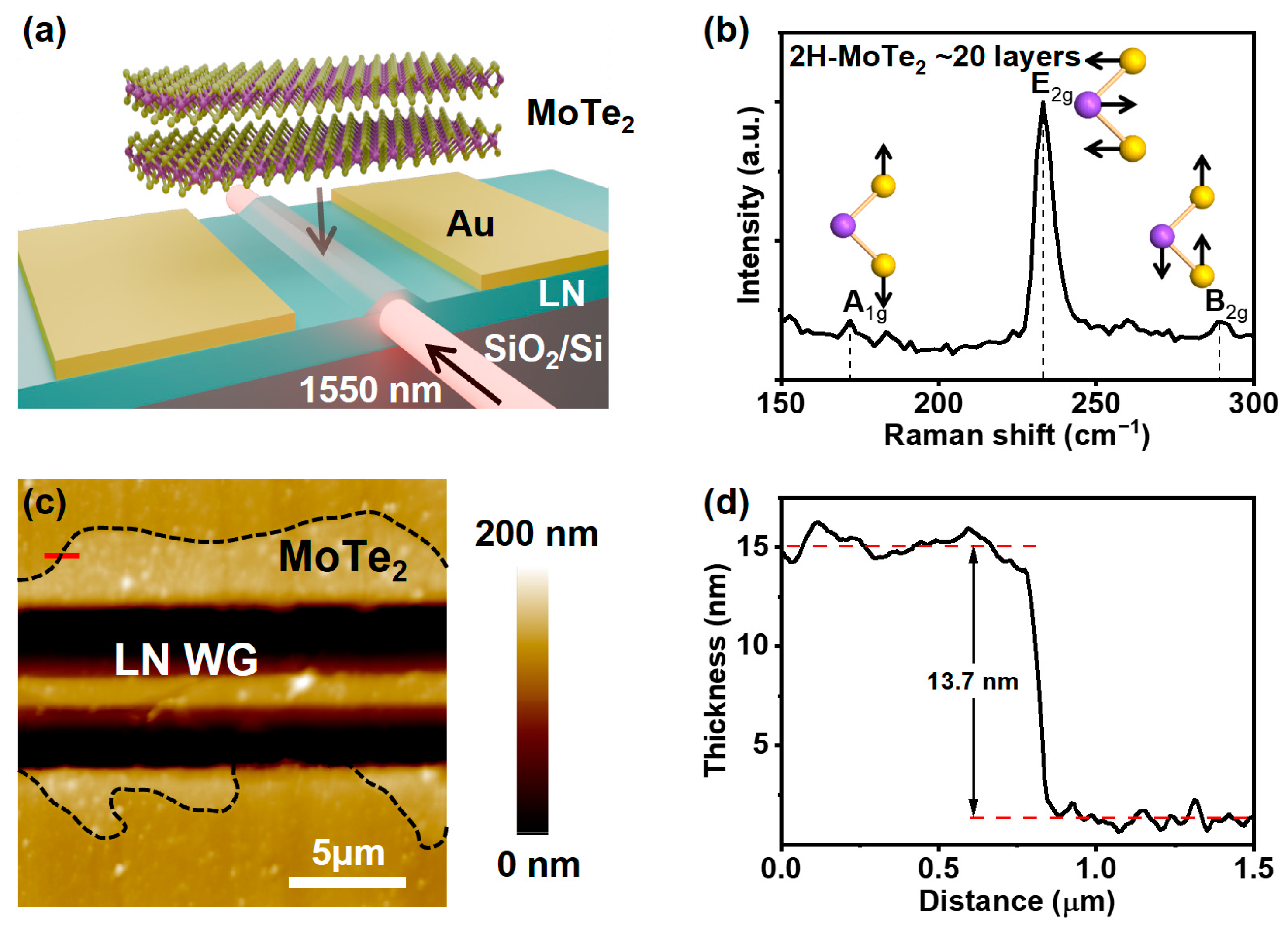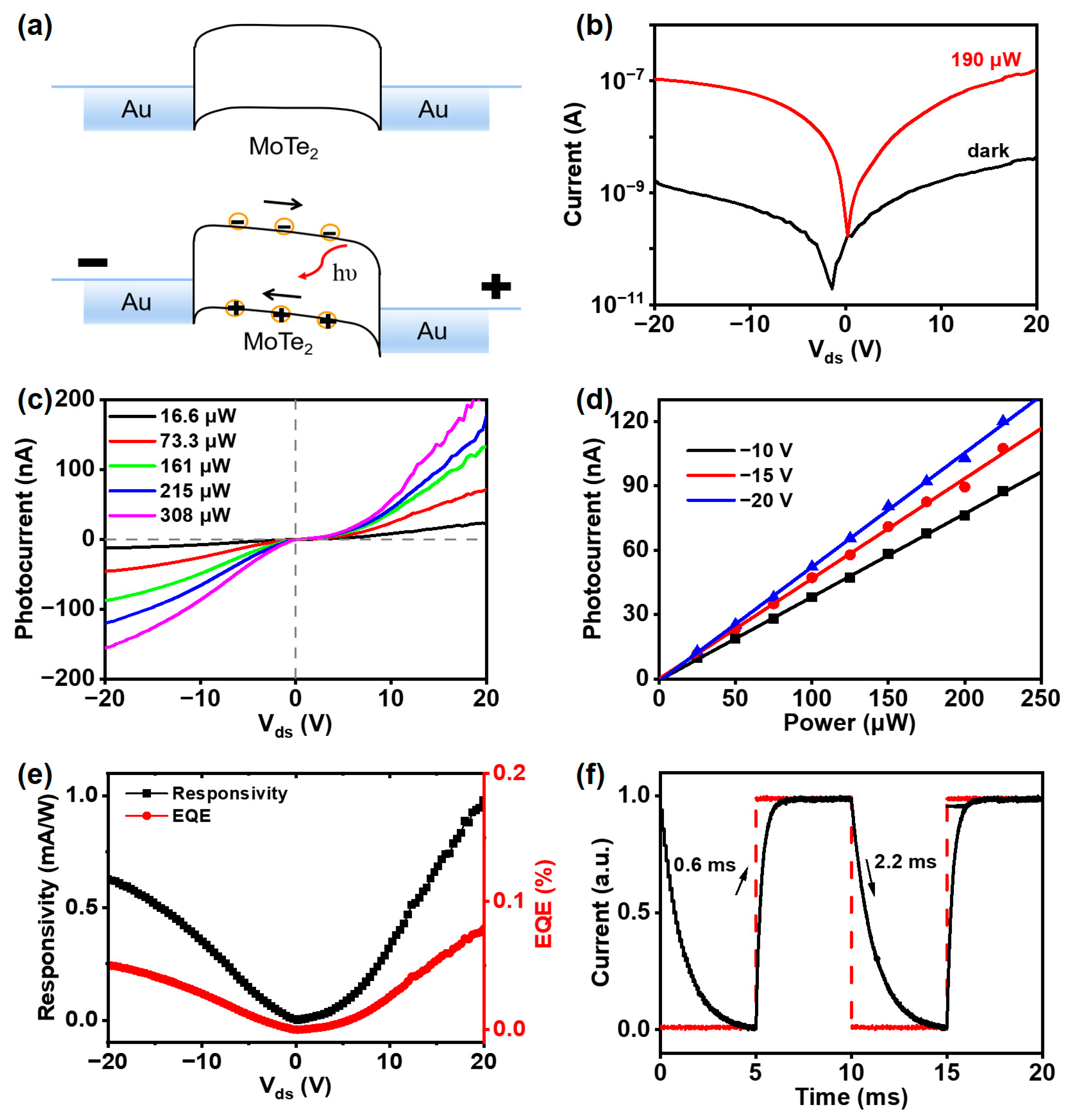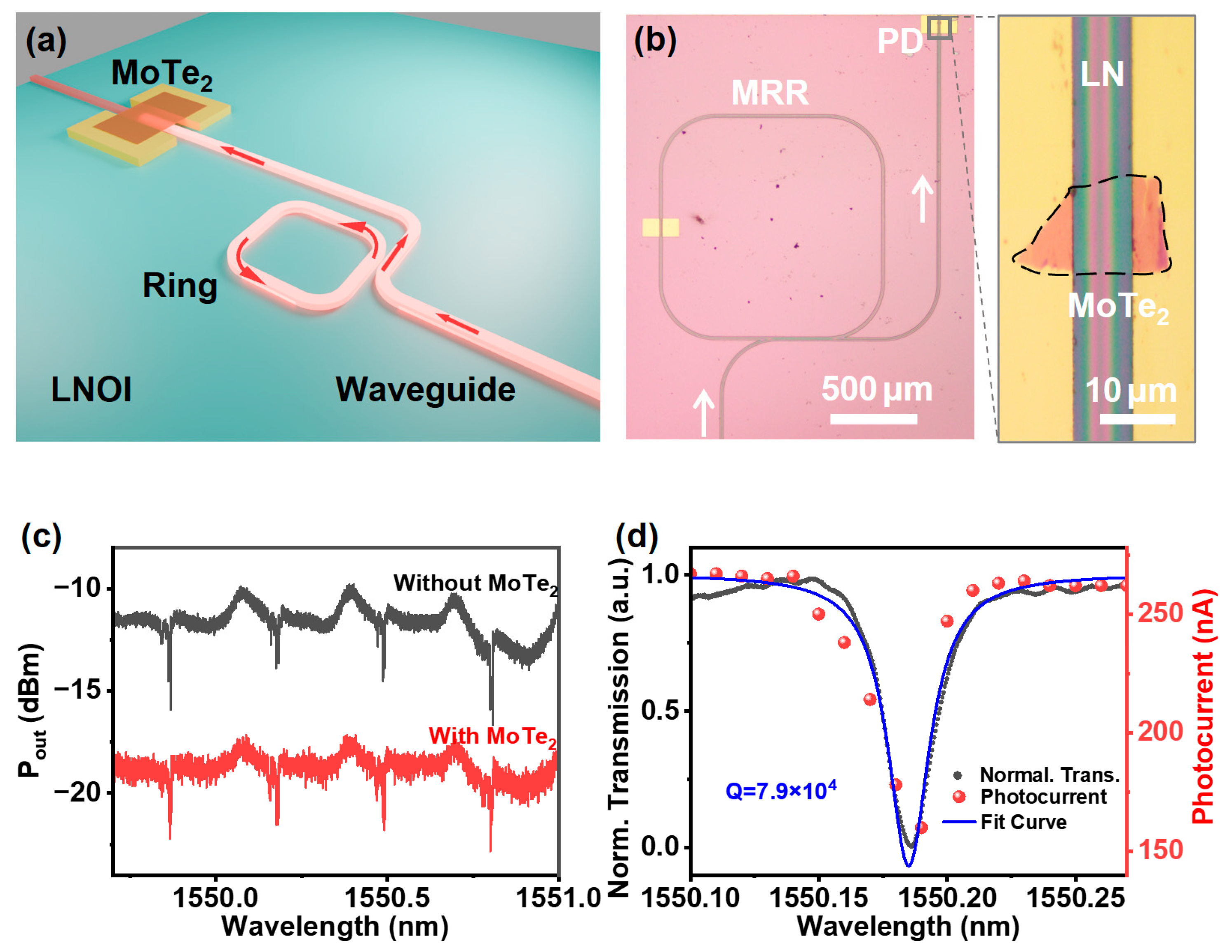MoTe2 Photodetector for Integrated Lithium Niobate Photonics
Abstract
1. Introduction
2. Materials and Methods
2.1. Materials and Fabrication of the On-Chip Photodetector
2.2. Mode Distribution and Absorption Simulation
2.3. Experimental Setup for Q Factor of LN Micro-Ring Resonator
2.4. Characterization of On-Chip Photodetector with Microresonator
3. Results and Discussion
4. Conclusions
Supplementary Materials
Author Contributions
Funding
Data Availability Statement
Conflicts of Interest
References
- Xiao, Z.; Liu, W.; Xu, S.; Zhou, J.; Ren, Z.; Lee, C. Recent Progress in Silicon-Based Photonic Integrated Circuits and Emerging Applications. Adv. Opt. Mater. 2023, 11, 2301028. [Google Scholar] [CrossRef]
- Lim, A.E.J.; Song, J.; Fang, Q.; Li, C.; Tu, X.; Duan, N.; Chen, K.K.; Tern, R.P.-C.; Liow, T.-Y. Review of Silicon Photonics Foundry Efforts. IEEE J. Sel. Top. Quantum Electron. 2014, 20, 405–416. [Google Scholar] [CrossRef]
- Sacher, W.D.; Huang, Y.; Lo, G.-Q.; Poon, J.K.S. Multilayer Silicon Nitride-on-Silicon Integrated Photonic Platforms and Devices. J. Light. Technol. 2015, 33, 901–910. [Google Scholar] [CrossRef]
- Nagarajan, R.; Kato, M.; Lambert, D.; Evans, P.; Corzine, S.; Lal, V.; Rahn, J.; Nilsson, A.; Fisher, M.; Kuntz, M.; et al. Terabit/s class InP photonic integrated circuits. Semicond. Sci. Technol. 2012, 27, 094003. [Google Scholar] [CrossRef]
- Boes, A.; Chang, L.; Langrock, C.; Yu, M.; Zhang, M.; Lin, Q.; Lončar, M.; Fejer, M.; Bowers, J.; Mitchell, A. Lithium niobate photonics: Unlocking the electromagnetic spectrum. Science 2023, 379, eabj4396. [Google Scholar] [CrossRef]
- Boes, A.; Corcoran, B.; Chang, L.; Bowers, J.; Mitchell, A. Status and Potential of Lithium Niobate on Insulator (LNOI) for Photonic Integrated Circuits. Laser Photonics Rev. 2018, 12, 1700256. [Google Scholar] [CrossRef]
- Lin, J.; Bo, F.; Cheng, Y.; Xu, J. Advances in on-chip photonic devices based on lithium niobate on insulator. Photonics Res. 2020, 8, 1910–1936. [Google Scholar] [CrossRef]
- Wu, R.; Wang, M.; Xu, J.; Qi, J.; Chu, W.; Fang, Z.; Zhang, J.; Zhou, J.; Qiao, L.; Chai, Z.; et al. Long Low-Loss-Litium Niobate on Insulator Waveguides with Sub-Nanometer Surface Roughness. Nanomaterials 2018, 8, 910. [Google Scholar] [CrossRef]
- Wu, R.; Gao, L.; Liang, Y.; Zheng, Y.; Zhou, J.; Qi, H.; Yin, D.; Wang, M.; Fang, Z.; Cheng, Y. High-Production-Rate Fabrication of Low-Loss Lithium Niobate Electro-Optic Modulators Using Photolithography Assisted Chemo-Mechanical Etching (PLACE). Micromachines 2022, 13, 378. [Google Scholar] [CrossRef] [PubMed]
- Zhang, K.; Sun, W.; Chen, Y.; Feng, H.; Zhang, Y.; Chen, Z.; Wang, C. A power-efficient integrated lithium niobate electro-optic comb generator. Commun. Phys. 2023, 6, 17. [Google Scholar] [CrossRef]
- Zhou, J.-X.; Gao, R.-H.; Lin, J.; Wang, M.; Chu, W.; Li, W.-B.; Yin, D.-F.; Deng, L.; Fang, Z.-W.; Zhang, J.-H.; et al. Electro-Optically Switchable Optical True Delay Lines of Meter-Scale Lengths Fabricated on Lithium Niobate on Insulator Using Photolithography Assisted Chemo-Mechanical Etching. Chin. Phys. Lett. 2020, 37, 084201. [Google Scholar] [CrossRef]
- Gao, R.; Guan, J.; Yao, N.; Deng, L.; Lin, J.; Wang, M.; Qiao, L.; Wang, Z.; Liang, Y.; Zhou, Y.; et al. On-chip ultra-narrow-linewidth single-mode microlaser on lithium niobate on insulator. Opt. Lett. 2021, 46, 3131–3134. [Google Scholar] [CrossRef] [PubMed]
- Liang, Y.; Zhou, J.; Liu, Z.; Zhang, H.; Fang, Z.; Zhou, Y.; Yin, D.; Lin, J.; Yu, J.; Wu, R.; et al. A high-gain cladded waveguide amplifier on erbium doped thin-film lithium niobate fabricated using photolithography assisted chemo-mechanical etching. Nanophotonics 2022, 11, 1033–1040. [Google Scholar] [CrossRef] [PubMed]
- Yang, Y.; Xu, Y.; Huang, D.; Li, F.; Dong, Y.; Zhang, B.; Ni, Y.; Wai, P.K.A. Thin-Film Lithium Niobate Based Acousto-Optic Modulation Working at Higher-Order TE1 Mode. Photonics 2022, 9, 12. [Google Scholar] [CrossRef]
- Xue, Y.; Han, Y.; Tong, Y.; Yan, Z.; Wang, Y.; Zhang, Z.; Tsang, H.K.; Lau, K.M. High-performance III–V photodetectors on a monolithic InP/SOI platform. Optica 2021, 8, 1204–1209. [Google Scholar] [CrossRef]
- Jin, C.; Wang, C.; Qu, L.; Zhang, D.; Liu, Q.; You, J.; Zheng, D.; Wu, W.; Cai, W.; Ren, M.; et al. Fast Lithium Niobate Photodetector. Laser Photonics Rev. 2023, 17, 2300503. [Google Scholar] [CrossRef]
- Elbanna, A.; Jiang, H.; Fu, Q.; Zhu, J.-F.; Liu, Y.; Zhao, M.; Liu, D.; Lai, S.; Chua, X.W.; Pan, J.; et al. 2D Material Infrared Photonics and Plasmonics. ACS Nano 2023, 17, 4134–4179. [Google Scholar] [CrossRef]
- Zou, Y.; Zhang, Z.; Yan, J.; Lin, L.; Huang, G.; Tan, Y.; You, Z.; Li, P. High-temperature flexible WSe2 photodetectors with ultrahigh photoresponsivity. Nat. Commun. 2022, 13, 4372. [Google Scholar] [CrossRef]
- Mawlong, L.P.L.; Ahn, J.H. 3D-Structured Photodetectors Based on 2D Transition-Metal Dichalcogenide. Small Struct. 2022, 3, 2100149. [Google Scholar] [CrossRef]
- Zhang, Y.; Shen, W.; Wu, S.; Tang, W.; Shu, Y.; Ma, K.; Zhang, B.; Zhou, P.; Wang, S. High-Speed Transition-Metal Dichalcogenides Based Schottky Photodiodes for Visible and Infrared Light Communication. ACS Nano 2022, 16, 19187–19198. [Google Scholar] [CrossRef]
- Manzeli, S.; Ovchinnikov, D.; Pasquier, D.; Yazyev, O.V.; Kis, A. 2D transition metal dichalcogenides. Nat. Rev. Mater. 2017, 2, 17033. [Google Scholar] [CrossRef]
- Lopez-Sanchez, O.; Lembke, D.; Kayci, M.; Radenovic, A.; Kis, A. Ultrasensitive photodetectors based on monolayer MoS2. Nat. Nanotechnol. 2013, 8, 497–501. [Google Scholar] [CrossRef] [PubMed]
- Yue, Z.; Shen, H.; Xu, Y.; Wang, Z.; Li, Y.; Zhang, J.; Li, H.; Zheng, J.; Chen, J.; Bai, H.; et al. Self-powered photodetectors with high detectivity based on MoSe2/Si heterojunction using ITO as the transparent electrode and highlight trapping structures. Surf. Interfaces 2023, 38, 102854. [Google Scholar] [CrossRef]
- Liang, X.; Guan, H.; Luo, K.; He, Z.; Liang, A.; Zhang, W.; Lin, Q.; Yang, Z.; Zhang, H.; Xu, C.; et al. Van der Waals Integrated LiNbO3/WS2 for High-Performance UV-Vis-NIR Photodetection. Laser Photonics Rev. 2023, 17, 2300286. [Google Scholar] [CrossRef]
- Ruppert, C.; Aslan, B.; Heinz, T.F. Optical Properties and Band Gap of Single- and Few-Layer MoTe2 Crystals. Nano Lett. 2014, 14, 6231–6236. [Google Scholar] [CrossRef]
- Ma, P.; Flöry, N.; Salamin, Y.; Baeuerle, B.; Emboras, A.; Josten, A.; Taniguchi, T.; Watanabe, K.; Novotny, L.; Leuthold, J. Fast MoTe2 Waveguide Photodetector with High Sensitivity at Telecommunication Wavelengths. ACS Photonics 2018, 5, 1846–1852. [Google Scholar] [CrossRef]
- Li, C.; Tian, R.; Chen, X.; Gu, L.; Luo, Z.; Zhang, Q.; Yi, R.; Li, Z.; Jiang, B.; Liu, Y. Waveguide-Integrated MoTe2 p-i-n Homojunction Photodetector. ACS Nano 2022, 16, 20946–20955. [Google Scholar] [CrossRef]
- Maiti, R.; Patil, C.; Saadi, M.A.S.R.; Xie, T.; Azadani, J.G.; Uluutku, B.; Amin, R.; Briggs, A.F.; Miscuglio, M.; Van Thourhout, D.; et al. Strain-engineered high-responsivity MoTe2 photodetector for silicon photonic integrated circuits. Nat. Photonics 2020, 14, 578–584. [Google Scholar] [CrossRef]
- Yang, F.; Hu, Y.; Ou, J.; Li, Q.; Zang, Z.; Fang, J.; Chen, J.; Han, H.; Cai, C.; Ruan, S.; et al. Low Dark Current, High Responsivity, and Self-Powered MoTe2 Photodetector Integrated with a Thin Film Lithium Niobate Waveguide. Adv. Opt. Mater. 2024, 12, 2401822. [Google Scholar] [CrossRef]
- Huang, T.; Ma, Y.; Fang, Z.; Zhou, J.; Zhou, Y.; Wang, Z.; Liu, J.; Wang, Z.; Zhang, H.; Wang, M.; et al. Wavelength-Tunable Narrow-Linewidth Laser Diode Based on Self-Injection Locking with a High-Q Lithium Niobate Microring Resonator. Nanomaterials 2023, 13, 948. [Google Scholar] [CrossRef]
- Liu, K.; Jin, N.; Cheng, H.; Chauhan, N.; Puckett, M.W.; Nelson, K.D.; Behunin, R.O.; Rakich, P.T.; Blumenthal, D.J. Ultralow 0.034 dB/m loss wafer-scale integrated photonics realizing 720 million Q and 380 μW threshold Brillouin lasing. Opt. Lett. 2022, 47, 1855–1858. [Google Scholar] [CrossRef]
- Feng, H.; Ge, T.; Guo, X.; Wang, B.; Zhang, Y.; Chen, Z.; Zhu, S.; Zhang, K.; Sun, W.; Huang, C.; et al. Integrated lithium niobate microwave photonic processing engine. Nature 2024, 627, 80–87. [Google Scholar] [CrossRef] [PubMed]
- Desiatov, B.; Lončar, M. Silicon photodetector for integrated lithium niobate photonics. Appl. Phys. Lett. 2019, 115, 121108. [Google Scholar] [CrossRef]
- Novoselov, K.S.; Geim, A.K.; Morozov, S.V.; Jiang, D.; Zhang, Y.; Dubonos, S.V.; Grigorieva, I.V.; Firsov, A.A. Electric Field Effect in Atomically Thin Carbon Films. Science 2004, 306, 666–669. [Google Scholar] [CrossRef]
- Li, Y.; Singh, A.; Krylyuk, S.; Davydov, A.; Jaramillo, R. Near-infrared photonic phase-change properties of transition metal ditellurides. Proc. SPIE Int. Soc. Opt. Eng. 2019, 11085. [Google Scholar] [CrossRef]
- Ji, X.; Bai, Z.; Luo, F.; Zhu, M.; Guo, C.; Zhu, Z.; Qin, S. High-Performance Photodetectors Based on MoTe2-MoS2 van der Waals Heterostructures. ACS Omega 2022, 7, 10049–10055. [Google Scholar] [CrossRef] [PubMed]
- Puotinen, D.; Newnham, R.E. The crystal structure of MoTe2. Acta Crystallogr. 1961, 14, 691–692. [Google Scholar] [CrossRef]
- Leong, W.S.; Wang, H.; Yeo, J.; Martin-Martinez, F.J.; Zubair, A.; Shen, P.-C.; Mao, Y.; Palacios, T.; Buehler, M.J.; Hong, J.-Y.; et al. Paraffin-enabled graphene transfer. Nat. Commun. 2019, 10, 867. [Google Scholar] [CrossRef]
- Qiu, Q.; Huang, Z. Photodetectors of 2D Materials from Ultraviolet to Terahertz Waves. Adv. Mater. 2021, 33, 2008126. [Google Scholar] [CrossRef] [PubMed]
- Jiang, J.; Wen, Y.; Wang, H.; Yin, L.; Cheng, R.; Liu, C.; Feng, L.; He, J. Recent Advances in 2D Materials for Photodetectors. Adv. Electron. Mater. 2021, 7, 2001125. [Google Scholar] [CrossRef]
- Kwon, J.; Lee, J.-Y.; Yu, Y.-J.; Lee, C.-H.; Cui, X.; Hone, J.; Lee, G.-H. Thickness-dependent Schottky barrier height of MoS2 field-effect transistors. Nanoscale 2017, 9, 6151–6157. [Google Scholar] [CrossRef] [PubMed]
- Brunetti, G.; Dell, F.; Conteduca, D.; Armenise, M.N.; Ciminelli, C. Comprehensive mathematical modelling of ultra-high grating-assisted ring resonators. J. Opt. 2020, 22, 3. [Google Scholar] [CrossRef]
- Chen, X.; Gan, X.; Zhu, Y.; Zhang, J. On-chip micro-ring resonator array spectrum detection system based on convex optimization algorithm. Nanophotonics 2023, 12, 715–724. [Google Scholar] [CrossRef] [PubMed]
- Bryan, M.R.; Butt, J.N.; Bucukovski, J.; Miller, B.L. Biosensing with Silicon Nitride Microring Resonators Integrated with an On-Chip Filter Bank Spectrometer. ACS Sens. 2023, 8, 739–747. [Google Scholar] [CrossRef]





Disclaimer/Publisher’s Note: The statements, opinions and data contained in all publications are solely those of the individual author(s) and contributor(s) and not of MDPI and/or the editor(s). MDPI and/or the editor(s) disclaim responsibility for any injury to people or property resulting from any ideas, methods, instructions or products referred to in the content. |
© 2025 by the authors. Licensee MDPI, Basel, Switzerland. This article is an open access article distributed under the terms and conditions of the Creative Commons Attribution (CC BY) license (https://creativecommons.org/licenses/by/4.0/).
Share and Cite
Dong, Q.; Sun, X.; Gao, L.; Zheng, Y.; Wu, R.; Cheng, Y. MoTe2 Photodetector for Integrated Lithium Niobate Photonics. Nanomaterials 2025, 15, 72. https://doi.org/10.3390/nano15010072
Dong Q, Sun X, Gao L, Zheng Y, Wu R, Cheng Y. MoTe2 Photodetector for Integrated Lithium Niobate Photonics. Nanomaterials. 2025; 15(1):72. https://doi.org/10.3390/nano15010072
Chicago/Turabian StyleDong, Qiaonan, Xinxing Sun, Lang Gao, Yong Zheng, Rongbo Wu, and Ya Cheng. 2025. "MoTe2 Photodetector for Integrated Lithium Niobate Photonics" Nanomaterials 15, no. 1: 72. https://doi.org/10.3390/nano15010072
APA StyleDong, Q., Sun, X., Gao, L., Zheng, Y., Wu, R., & Cheng, Y. (2025). MoTe2 Photodetector for Integrated Lithium Niobate Photonics. Nanomaterials, 15(1), 72. https://doi.org/10.3390/nano15010072





